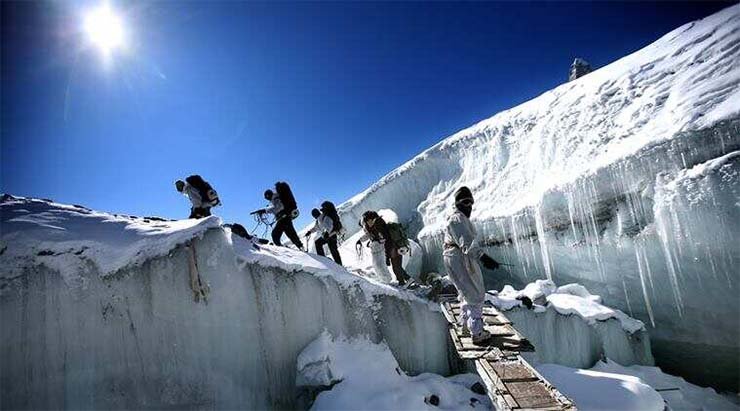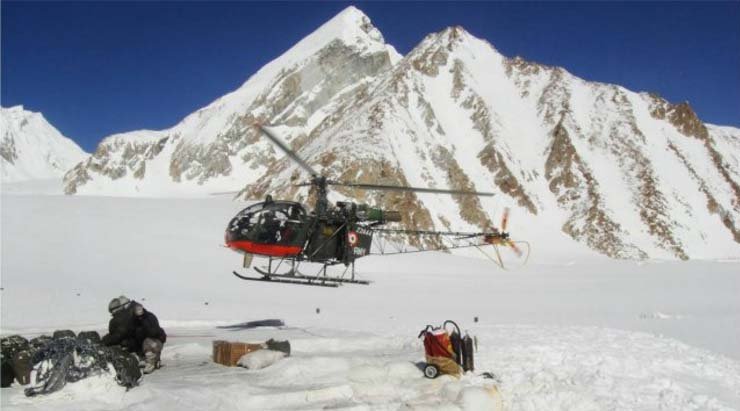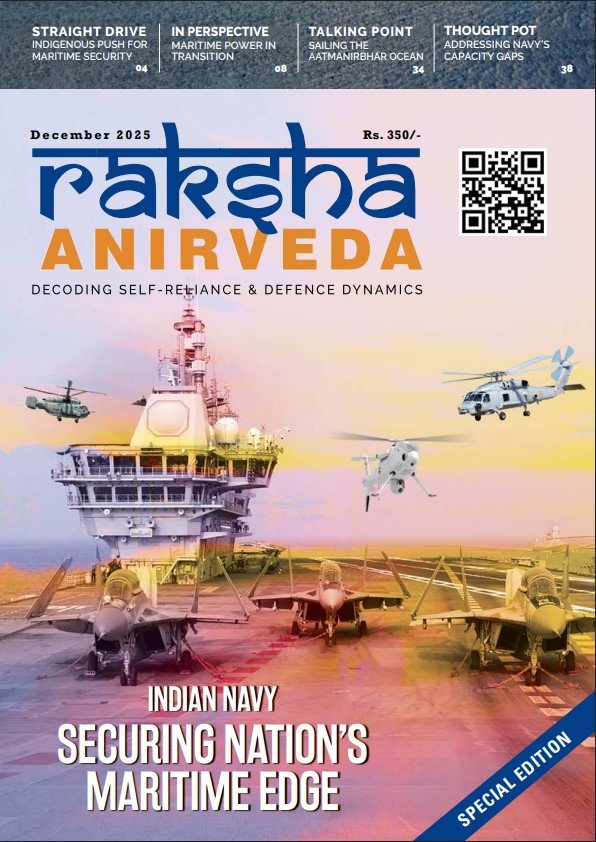Siachen – the highest battlefield in the world, is located in the eastern Karakoram ranges of the Himalayas in the Union Territory of Ladakh. Siachen often called the Third Pole — is also known as the “Garden of roses” in the Balti dialect. “Sia” in the Balti language refers to the rose plant while “Chen” refers to an object found in abundance. Thus the name Siachen refers to the land with an abundance of roses. Siachen flanked by Saltoro ridge and Karakoram Range — is the longest glacier in the Karakoram and the second longest in the non-polar region.
The Glacier originates from Indira Col in North at the altitude of 21000 feet and rolls down 74 km away to Partapur Base camp to 12000 feet.
It is a slow-moving mass of snow with frequent avalanches and hidden deep crevasses. Siachen region extends to 2500 sq km. The average snowfall is more than 1000 cms (25 feet) and the temperature in winter goes as low as minus (-) 50 degrees Celsius.
The Saltoro ridge in the west of Siachen starts from Sia Kangeri top on Indo Tibet Border to NJ 9842. The major passes from North to South are Sia La (5589 metres), Bilafond La meaning “Pass of the Butterflies” in Balti language, also known as the Saltoro Pass (5450 metres), Gyong La (5689 metres), Yarma La (6100 metres) and chulung La (5800 metres).
The Nubra River referred to as Yarma Tsangpo in the Tibetan Maps originates from the southeastern tip of Siachen and joins the Shyok River (River of death) which flows through Ladakh in India before joining the 3000-kilometre-long Indus River which flows through Pakistan. Hence Siachen is an important source of freshwater supply for river systems in both India and Pakistan.
Operation Meghdoot (name drawn from an ancient epic written by Kalidas. Megh means cloud and Doot – means messenger) — the first military offensive of its kind anywhere in the world- was launched on 13 April 1984 by the Indian Army to seize control over the Siachen Glacier and pre-empt Operation Ababeel (meaning a flock of birds) by Pakistan Special Service Group to capture the Siachen Glacier taking advantage of the undemarcated Line of control beyond NJ9842.
The Siachen Glacier had been a bone of contention between India and Pakistan because of the vague demarcation of boundaries in the Karachi Agreement of July 1949 which did not exactly specify who had authority over the Siachen Glacier area. After the India-Pakistan War of 1947-48, the International border ended at Akhnoor and the Cease Fire Line (CFL) under the supervision of the UN was marked as per the position of troops. After the Indo-Pak War of 1965, the Tashkent agreement signed between Indian PM Lal Bahadur Shastri, and President Ayub Khan of Pakistan, the CFL was converted to the Line of Control (LOC) and Siachen was classified as a no man’s land. India claimed that LOC went northwards from NJ 9842 while Pakistan interpreted that it headed northeast from Point NJ9842 to the Karakoram Pass. However, in spite of contradictory claims over the barren heights – the Siachen Glacier remained unoccupied till 1984.
How India Captured Siachen
Pakistan permitted several mountaineering expeditions to climb the Siachen glacier from the Pakistani side, in an attempt to reinforce their claim on the area. In many cases, a liaison officer from the Pakistan Army accompanied the teams. Significantly the map provided by the Pak Military, obtained by RAW from a member of the German Expedition showed the Siachen as Pak territory and LOC linking from NJ9842 to Karakoram Pass.
The Indian Army too launched a few expeditions to recce the area. One of the most important such expeditions included the one led by Col Narinder (Bull) Kumar – widely known as the father of high-altitude warfare in India to Teram Kangri Peak. One of the objectives of this expedition was to upgrade the map of the area as well as photographs and videos of the area beyond Saltoro ridge also called Peak 36. To honour Col Kumar’s valuable contribution in this first-ever mission by India to stake claim over the Glacier – the Indian Army’s Battalion HQ and base camp in the Siachen Glacier is called Kumar Base. This was also the first time in history when an Indian Air Force Chetak helicopter landed at Siachen to provide logistic support and supply of fresh rations to the expedition on 6 October 1978.
In April 1981, Kumar returned to the Siachen Glacier with a 70-member team and become the first to climb the Siachen Glacier. In this expedition, which lasted about eight weeks, the team climbed Saltoro Kangri I (25,400 feet), Sia Kangri I (24,350 ft), and Indira Col (24,493 ft) before skiing to Bilafond La, Saltoro Pass, Sia La, Turkistan La and Pass Italia passes on Saltoro.
Meanwhile, in 1984 the Indian intelligence agencies reported Pakistan’s intention to launch operation Ababeel and large-scale procurement of arctic clothing, snow tents and mountaineering equipment from London. This helped the then Prime Minister of India, Indira Gandhi, authorise Operation Meghdoot based on the detailed topographical mapping exercise and wealth of information culled out by Col Bull Kumar’s expeditions to the Siachen glacier.

The Plan was discussed in the Cabinet Committee of Security. Armed with the green signal the then Chief of Army Staff Gen Arun Vaidya, directed the Northern Army Commander Lt Gen P N Hoon and Brig Vijay Channa the task force commander of 26 Sector to occupy Saltoro Heights at the earliest. As a result, troops of the Kumaon Regiment and Ladakh scouts equipped with fully snow clothing were ordered to assemble at the Siachen Base Camp. The massive logistics build-up at Leh was made possible by the IAF’s fleet of IL 76 and AN 32 transport aircraft. Within no time the Indian troops occupied Sia La, Bilafond La, and Gyong La all three major mountain passes along with commanding heights of Saltoro Ridge of the Siachen Glacier.
As a result, the Pakistani troops who arrived there were in for a big surprise and were beaten back with heavy casualties. Hence Op Meghdoot was a big success and the Indian Tricolour was hoisted on the highest battlefield in the world where it could be seen 20 km away by the adversary.
Presented with a fait accompli the Pakistanis launched a number of counterattacks but failed – each time with heavy losses. The whole world was surprised by the Indian Army’s daring operation.
The former Pakistani president, Gen Pervez Musharraf admitted in his memoirs, that Pakistan lost nearly 2,553.0 sq. km of territory.
Paradoxically the Siachen Glacier remains the highest and perpetual battlefield where the Indians and Pakistani continue to fight intermittently. More than 2000 people have died in this inhospitable terrain, mostly due to extreme weather and the hazards of mountain warfare.
Both countries maintain a permanent military presence at a height of over 20,000 ft in the region where skirmishes are a matter of routine. Up to ten infantry battalions each of the Indian and Pakistan Army are actively deployed at high altitudes throughout the glacier region. It is quite an inhuman task, but to make it possible the Units were rotated after every six months keeping in view the inclement weather, lack of Oxygen, Snow blizzards, and -50 degree temperature.
Aftermath – the never-ending war
In early 1987, commandos of the 3rd Shaheen Company of Pakistan Army Special Service Group (SSG) led by then Brigadier Pervez Musharraf occupied the world’s highest military post at a height of 6,749 metres (22,143 feet) near the Bilafond La pass. The post was so strategically important that Pakistan named it the ‘Quaid’ Post, after Quaid-e-Azam, Muhammad Ali Jinnah. The Quaid post gave them a clear view of Indian Army posts up to 80 km along the entire Saltoro range and the Siachen glacier — about 15 km away.
On 18 April 1987 the Pakistani commandoes occupying the Quaid Post started firing at the Indian troops at the Sonam post the world’s highest helipad at 6,400 metres (21,000 feet), killing a junior commissioned officer (JCO) and five soldiers. The Pakistanis also started firing at Indian helicopters, preventing them from dropping supplies to the Amar post, located to the south of the Quaid Post.
This provoked Lt Col A P Rai, the Commanding Officer (CO) of 8 JAK Li (J&K Light Infantry) vow to neutralise the Quaid Post. So after meticulously planning the operation in detail, he tasked a highly trained commando patrol equipped with proper mountaineering equipment to attack the Quaid post. It took over 35 helicopter sorties just to transport the team and its supplies. The aim was to identify different accesses to the post and to find out how many Pakistanis were manning the Quaid post. Accordingly, after due acclimatization, the 13-men team led by 2nd Lt Rajiv Pandey started trekking in the dark night towards the ice wall leading to the Quaid Post on 29 May 1987.
The Quaid post was virtually an impregnable glacier fortress with steep 80° to 90° ice walls on three sides and a thin razor-sharp ridge line on the fourth side. To make the task all the more difficult, a snow blizzard reduced the visibility and the patrol had to halt every few meters to regain their breath in the sub-zero temperatures and wind speeds reaching 125 km.
Lt Rajiv and his men tried their best to silently climb the peak without being noticed by the Pakistani soldiers at the top. But unfortunately, the Pakistanis were waiting for them to come into the firing range and opened LMG fire killing 10 Indian soldiers, including 2nd Lt Rajiv Pande. Their lifeless bodies rolled down from the cliff while the only two survivors who were down below waiting for their turn to start climbing reached the Battalion Headquarters to narrate the bravery of their fallen comrades. This prompted Lt Col Rai to make another attempt to capture the Quaid post. So he coined the plan for Operation Rajiv, which was approved by Brig Chandan Singh Nugyal his brigade commander.
Operation Rajiv
After these intense preparations, ‘Operation Rajiv’ (named in honour of Second Lieutenant Rajiv Pande) was launched on the evening of 23 June 1987. It was led by Major Varinder Singh, his deputy Captain Anil Sharma and had 3 JCOs and 57 troops. Another 10-man team led by Captain Ram Prakash was asked to provide covering fire using rocket launchers.

A platoon set out to find the rope fixed by Pande’s patrol. But they managed to trek only a few hundred metres in waist-deep snow till 4 am the next morning due to heavy snowfall and returned back to the base camp.
The attack begins
On the 24th at 8 pm, the entire team led by Major Varinder began trekking again in waist-deep snow. As planned earlier, the assault groups were split into three teams led by Subedar Harnam Singh, followed at a distance by another team led by Subedar Sansar Chand and a third reserve team led by Naib Subedar Bana Singh.
The first group of Indian soldiers had barely climbed a distance of 50 m when the Pakistanis opened fire killing 3 Indian soldiers. But the Indian troops were unable to retaliate as their weapons jammed in the -25 °C temperature. The Indian troops also could not ask for artillery support as the shells could deviate erratically and harm their own colleagues due to high winds.
Despite heavy Pakistani fire, Major Varinder Singh and his men succeeded in climbing the cliff but were forced to take cover about 200 m away from the top.
Meanwhile, Sub Sansar Chand and his team reached the top of the Quaid Post and destroyed two enemy bunkers despite intense firing by the Pakistanis. But could not communicate with Major Varinder and his men because the battery of his radio set drained out. So Sub Sansar Chand sent a sepoy to report his position to Major Varinder Singh who was close behind. Unfortunately, the runner was gunned down before delivering the message.
Meanwhile, Naib Subedar Bana Singh and his soldiers started the final assault and decided to take the long and extremely dangerous route – along a steep 457 metres (1,500 ft) high wall of ice under the cover of darkness to avoid being detected. Their effort paid off as the Pakistani soldiers were caught unaware as they were not expecting anyone to take this hazardous route in the bitter cold and poor light conditions.
After several hours, they managed to reach the top and found one Pakistani bunker and a few trenches. Instinctively Naib Subedar Bana Singh and his men split up into two groups and surrounded the bunker occupied by the Pakistani SSG commandoes. Before the overconfident Pakistani soldiers could react, Bana Singh crawled all the way till the bunker and lobbed a grenade killing all the men inside it.
What followed next was fierce hand-to-hand combat using bayonets to attack and kill the Pakistani soldiers in the trenches. In this manner, Bana Singh and his team finally captured the Quaid post before firing the flare signifying the victory of the Indian Army. By then, Major Varinder Singh also reached the top where he and his exhausted men had their first meal in three days.
Obviously, Brig Pervez Musharraf was so much upset with the manner in which the Indians Soldiers captured the Quaid Post that he ordered indiscriminate Pakistani artillery shelling on the post in which Sepoy Om Raj’s hand was blown off and Maj Varinder Singh too was seriously wounded. However, Maj Varinder Singh refused to be evacuated and continued to command his troops. Under his leadership, the Indian 8 J&K Light Infantry jawans forced the Pakistanis to withdraw and hoisted the tricolour on the Quaid post which was subsequently renamed as Bana post and the ‘saddle’ in the ridge-line was nicknamed ‘Viru saddle’ after Major Varinder.
In this manner, Maj Varinder Singh walked down the hill using his right hand to stop the wounds from further bleeding and recover after a 15-day hospital stay in Leh with 17 stitches.
Bana Singh was promoted to the rank of Subedar and awarded the Param Veer Chakra India’s highest wartime gallantry award for conspicuous bravery. Before his retirement on 31 Oct 2000, Bana was made Subedar Major and later Honorary Captain.
Sub Sansar Singh and Sub Harnam Singh were awarded Mahavir Chakra while seven others including Maj Varinder Singh and 2nd Lieutenant Rajiv Pande (posthumously) were awarded Veer Chakra. Maj Varinder Singh went on to become a Brigadier while Col Rai was awarded the Uttam Yuddha Sewa Medal (UYSM).
Later, the Indians respectfully handed over the dead bodies of Pakistani soldiers during a flag meeting in Kargil. But, revengeful Musharraf led a major Pakistani attack on the Bilafond Pass in Sept 1987 in which about 1,000 Pakistani men lost their lives. Once again Pakistan tried to reclaim the Siachen glacier in 1990, 1995, 1996 and 1999 – but failed in each of these attempts.
Op Meghdoot has the dubious distinction of being the longest war between two countries (38 Years long) fought on the highest altitude. India continues to spend over Rs 2,000 crore a month to sustain troops on the Siachen glacier and provide them with better equipment, food and weather forecasting machines.
Whenever the troops are ready to induct, they take the blessings of OP Baba the legendary keeper of Glacier, at a temple at Siachen base camp, for safe return after completion of duty. The Siachen warriors, who are constantly at war with two enemies – Pakistan and the inhospitable weather — are the true heroes of the nation.
A memorial at the Siachen Base camp befittingly reads: “Quartered in snow, silent to remain. When the bugle calls, they shall rise and march again!”
-The writer is an Indian Army veteran and a defence analyst. He has keen interest in Geo-strategic affairs and writes regularly on internal and external affairs issues related to India and neighbours. The views expressed are personal and do not necessarily reflect the views of Raksha Anirveda.
-The writer is an Indian Army veteran and a defence analyst. He has keen interest in Geo-strategic affairs and writes regularly on internal and external affairs issues related to India and neighbours. The views expressed are personal and do not necessarily reflect the views of Raksha Anirveda






